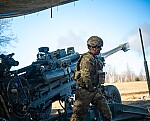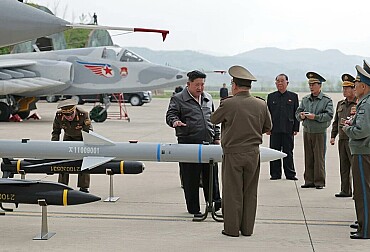Russia’s Nuclear Missile Burevestnik: Tensions Between Washington and Moscow Rise
Russia has announced the successful completion of the final test of its Burevestnik nuclear-powered cruise missile. Behind this weapon — which promises theoretically unlimited range and unmatched endurance — lies a strategic ambition: to restore Russian technological supremacy in the nuclear domain.
The Burevestnik missile (NATO designation: SSC-X-9 Skyfall) represents a major breakthrough in modern weaponry. Designed by the Novator Design Bureau and developed under the Russian Ministry of Defense, it combines the aerodynamic profile of a cruise missile with a miniaturized nuclear propulsion system. According to Russian Chief of the General Staff Valery Gerasimov, the missile traveled approximately 14,000 kilometers during its final flight, lasting about fifteen hours, without any notable incidents.
Vladimir Putin described the missile as a “unique creation that no one else in the world has,” emphasizing that the system has now reached operational status. The missile, approximately 12 meters long, is reportedly powered by a turbojet engine that uses heat from a compact nuclear reactor to superheat incoming air. This propulsion method gives it virtually unlimited range — a capability unprecedented in cruise missiles. This technology, first explored by the United States in the 1950s under Project Pluto, was never implemented due to severe radiological risks. Moscow now claims to have overcome this barrier, asserting that the Burevestnik combines nuclear thermal propulsion with variable-trajectory guidance, enabling it to evade Western radar and missile defense systems.
Official information from the Russian Ministry of Defense remains limited, but images released during the announcement show a missile with an elongated fuselage, retractable mid-body wings, and a ramjet-style front air intake. Its reduced radar cross-section, combined with a low-altitude flight profile (30–60 meters), makes it extremely difficult to intercept. According to technical data shared with Washington as part of test notification protocols, the missile reached an average altitude of 1,000 meters before stabilizing its trajectory toward the Barents Sea. Its speed, estimated at Mach 0.8 to 0.9, aligns it with subsonic cruise missiles like the Kalibr or Tomahawk, but its nuclear propulsion enables missions of extreme duration — potentially remaining airborne for days.
This endurance enables unprecedented attack scenarios: a missile that can bypass defenses, loiter in holding patterns, or strike from unexpected vectors. If deployed, a single Burevestnik could threaten multiple continents simultaneously.
The Burevestnik is a cornerstone of Russia’s “dynamic deterrence” doctrine. By circumventing arms control treaties — from which Moscow has progressively withdrawn — Russia is developing an “asymmetric” delivery system. In response to U.S. missile defense systems (Aegis Ashore, THAAD), Russia relies on unpredictable flight paths and propulsion independent of chemical fuel. Additionally, nuclear propulsion produces a stable thermal signature, reducing detectability by infrared early-warning systems.
The primary challenge lies in miniaturizing and safely containing the onboard nuclear reactor. According to technical documents reviewed by the Kyiv Independent, the reactor uses a highly enriched uranium core with a direct air-cycle heat exchange system and no secondary containment barrier. While this design maximizes efficiency, it poses a severe risk of radioactive contamination in the event of a failure. Western experts have nicknamed it the “flying Chernobyl” due to the potential for atmospheric radioactive dispersal during a launch mishap. Despite these concerns, Moscow insists on the system’s reliability. General Gerasimov stated that the latest flight “validated all propulsion and guidance parameters.” Russia is now considering limited pre-production at the Arzamas-16 complex, which specializes in tactical nuclear systems.
Technically, the Burevestnik upends traditional nuclear deterrence. Unlike intercontinental ballistic missiles (ICBMs), which follow predictable parabolic trajectories, this system can fly at low altitude, maneuver mid-flight, and strike from any direction. This renders many early-warning systems — designed to detect ballistic launches — ineffective. For Russia, the weapon serves as a political signal: proof that, despite sanctions and the war in Ukraine, it retains a technological edge in select military domains.
On the military front, the missile’s operational value remains debated: its subsonic speed, high cost, and radiological risks may limit its utility compared to hypersonic systems like the Avangard. Nevertheless, in strategic communication, the Burevestnik plays a powerful symbolic role. It allows Moscow to project innovation and resilience, contrasting Russian nuclear modernity with what the Kremlin calls the “technological decline of the West.”
The U.S. response was immediate. Speaking to journalists aboard Air Force One en route to Japan, President Donald Trump called the announcement “inappropriate.” He sharply criticized Putin, urging the Russian leader to focus on ending the war in Ukraine — a conflict that began in 2022 and is now entering its fourth year — by increasing military support for Kyiv. Trump also referenced a U.S. nuclear submarine, which he described as “the best in the world,” stationed off the Russian coast. These remarks underscore the persistent tensions between Washington and Moscow and highlight the high stakes of such military demonstrations.
The United States recently imposed sanctions on two Russian energy giants, Rosneft and Lukoil, amid escalating geopolitical friction. These measures mark Trump’s first significant actions against Russia since returning to office and aim to intensify pressure on Moscow, already strained by battlefield setbacks. The Trump-Putin relationship has been turbulent. Although a meeting in Budapest was considered, Trump ultimately declined, reflecting the complex and often contradictory ties between the two nations.








